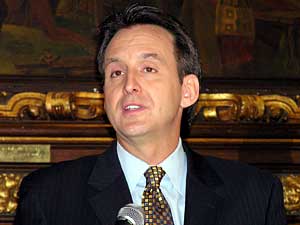 |
| Gov. Pawlenty hailed the state's projected budget surplus as the "biggest financial turnaround in the state's history." (MPR Photo/Laura McCallum) |
St. Paul, Minn. — Minnesota hasn't had a positive revenue forecast since February 2001, before the nation's economy was hit by the post-September 11 recession.
Right after Gov. Pawlenty was elected, the state's deficit reached a record $4.5 billion. Now, the nation's economy is rebounding, and state tax collections are coming in higher than expected. Finance Commissioner Peggy Ingison was happy to report the first surplus in more than four years.
"This forecast is good news for Minnesota. We've got a $701 million balance that's projected for the current biennium - 2006-2007 - and that will all be used for buying back the school shift," said Ingison.
The school shift Ingison refers to is money that was borrowed from school districts during the state's budget crunch. Lawmakers delayed school aid payments to help close the budget gap, and by law, must now make payments on schedule.
Of course, lawmakers could decide to dip into that money when they return in March, but no one is calling for that at this point.
In addition to the $700 million surplus, the state also has about $300 million in the bank from higher tax collections in the last fiscal year.
Gov. Pawlenty described the swing from red ink to black as the biggest financial turnaround in state history. He ticked off the state's economic statistics as if he were on the campaign trail.
"We have one of the lowest rates of unemployment in the country, at 3.9 percent, we have one of the highest rates of workforce productivity and workforce engagement in the country, including the percent of women in the workforce," Pawlenty said. "We have one of the highest per-capita concentrations of Fortune 500 companies in Minnesota. Our manufacturing sector in Minnesota is stable and growing."
While it's true that Minnesota has added manufacturing jobs in recent months, overall job growth lags behind the national average.
DFL leaders were quick to point out the job numbers and other areas of concern, such as high energy prices, in the forecast. House Minority Leader Matt Entenza of St. Paul says the surplus is only a surplus on paper, because it doesn't account for inflation.
Entenza says the state underinvested in education, health care and other needs during the lean years, and homeowners are picking up a bigger share of state spending.
"Average Minnesotans have seen their property taxes go up, their home heating costs go up, and they don't have a surplus at home," said Entenza. "And the state of Minnesota does not have a surplus either because we have not paid the bills that are due."
Entenza and other DFL leaders say the state should use some of the extra cash on hand for property tax relief for homeowners.
Republican leaders are also talking about property tax relief, although they wouldn't specify whether they want to help homeowners or businesses. And there will plenty of other competing demands for the additional money.
Environmental groups want to use some of it to clean up polluted waters in the state, and advocates for low-income people say it should be used to undo cuts to social service programs made during the deficit years.
Trishalla Bell from the Welfare Rights Committee says cuts to welfare and health care programs have hurt low-income people in the state.
"That money belongs to us, because we are the ones who have had to suffer since 2003 with those cuts," said Bell. "That money came from the programs that serve us, so every single penny of that money needs to go back into the health and human service division, so that way they can start undoing cuts."
Some lawmakers are also talking about spending more money on road construction, and using some of the extra cash to pay debt on a large capital improvements bill.
But before legislators make any of those decisions, they'll receive another revenue forecast shortly before they return to the Capitol in March.






